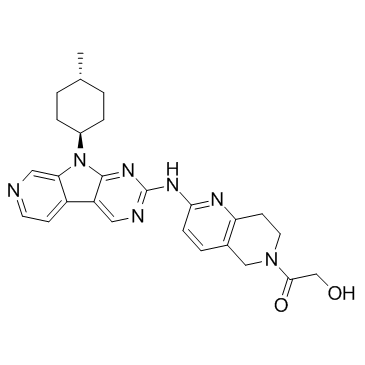1401033-86-0
| Name | 1-[7,8-Dihydro-2-[[9-(trans-4-methylcyclohexyl)-9H-pyrido[4',3':4,5]pyrrolo[2,3-d]pyrimidin-2-yl]amino]-1,6-naphthyridin-6(5H)-yl]-2-hydroxyethanone |
|---|---|
| Synonyms |
2-Hydroxy-1-[2-{[9-(trans-4-methylcyclohexyl)-9H-pyrido[4',3':4,5]pyrrolo[2,3-d]pyrimidin-2-yl]amino}-7,8-dihydro-1,6-naphthyridin-6(5H)-yl]ethanone
2-hydroxy-1-(2-((9-((1r,4r)-4-methylcyclohexyl)-9H-pyrido[4′,3′:4,5]pyrrolo[2,3-d]pyrimidin-2-yl)amino)-7,8-dihydro-1,6-naphthyridin-6(5H)-yl)ethanone Ethanone, 1-[7,8-dihydro-2-[[9-(trans-4-methylcyclohexyl)-9H-pyrido[4',3':4,5]pyrrolo[2,3-d]pyrimidin-2-yl]amino]-1,6-naphthyridin-6(5H)-yl]-2-hydroxy- 2-hydroxy-1-[2-({9-[(1r,4r)-4-methylcyclohexyl]-9H-pyrido[4',3':4,5]pyrrolo[2,3-d]pyrimidin-2-yl}amino)-7,8-dihydro-1,6-naphthyridin-6(5H)-yl]ethanone 2-hydroxy-1-(2-((9-((1R,4R)-4-methylcyclohexyl)-9H-pyrido[4',3':4,5]pyrrolo[2,3-d]pyrimidin-2-yl)amino)-7,8-dihydro-1,6-naphthyridin-6(5H)-yl)ethanone AMG 925 AMG-925 |
| Description | AMG 925 is a potent, selective, and orally available FLT3/CDK4 dual inhibitor with IC50s of 2±1 nM and 3±1 nM, respectively. |
|---|---|
| Related Catalog | |
| Target |
FLT3:2 nM (IC50) CDK4:3 nM (IC50) CDK6:8 nM (IC50) CDK2:375 nM (IC50) CDK1:1.9 μM (IC50) |
| In Vitro | AMG 925 also inhibits CDK6, CDK2, and CDK1 in kinase assays with IC50s of 8±2 nM, 375±150 nM, 1.90±0.51 μM, respectively. A fair overall kinase selectivity of AMG 925 is as determined by KinomScan against a panel of 442 various kinases. Cellular selectivity (on-target vs. off-target activity) of AMG 925 is about 50-fold as evaluated by comparison of its growth-inhibiting activity in RB-positive (RB+) and RB-negative (RB-) non- acute myeloid leukemia (AML) cancer cell lines. AMG 925 potently inhibits growth of AML cell lines MOLM13 (FLT3-ITD; IC50=19 μM) and Mv4-11 (FLT3-ITD; IC50=18 μM)[1]. |
| In Vivo | MOLM13 tumor-bearing mice are dosed twice daily by oral administration 6 hours apart with 12.5, 25, or 37.5 mg/kg AMG 925. Tumors are then harvested 3, 9, 12, and 24 hours after the first dose, and analyzed for levels of P-STAT5 and P-RB. Maximum inhibition of P-STAT5 and P-RB is achieved at 6 and 12 hours respectively at the 37.5 mg/kg dose of AMG 925. Interestingly, a rebound of P-STAT5 at 24 hours is observed, possibly as a result of compensational feedback. The pharmacodynamic responses of P-STAT5 and P-RB inhibition correlated with plasma concentrations of AMG 925. AMG 925 inhibits AML xenograft tumor growth by 96% to 99% without significant body weight loss. The antitumor activity of AMG 925 correlates with the inhibition of STAT5 and retinoblastoma protein (RB) phosphorylation, the pharmacodynamic markers for inhibition of FLT3 and CDK4, respectively. In addition, AMG 925 is also found to inhibit FLT3 mutants (e.g., D835Y) that are resistant to the current FLT3 inhibitors (e.g., AC220 and Sorafenib)[1]. |
| Cell Assay | MOLM13 and Mv4-11 are used. MOLM13-Luc cells are constructed by transduction of MOLM13 cells with the pLV218G luciferin/lentivector, which expresses luciferase under the murine EF1α promoter. Sorafenib-resistant MOLM13 (MOLM13sr) and Mv4-11 (Mv4-11sr) are isolated by passaging the cells in growth medium containing increasing concentrations of Sorafenib (1-1 nM). Cell growth is measured by a DNA synthesis assay. Cells are seeded in a 96-well Cytostar T plate at a density of 5×103 cells/well in a total volume of 160 μL. Test compounds (e.g., AMG 925; 0.03 and 0.3μM) are serially diluted into the plate (20 μL/well) and 20 μL/0.1 μCi of [14C]-Thymidine added to each well. Isotope incorporation is determined using a β plate counter after further 72-hour incubation. Apoptosis is assayed by using the Vybrant Apoptosis Assay Kit. Briefly, cells are seeded into a 6-well plate at 5×105 cells per well and treated with compounds (e.g., AMG 925; 0.003, 0.01, 0.03, 0.1, 0.3, and 1 μM) for 24 hours. The cells are then stained with reagents provided in the kit and analyzed by flow cytometry. The Sytox Green fluorescence versus allophycocyanin fluorescence dot plot shows resolution of live, apoptotic, and dead cells, which are quantified using the Flowjo software. The cell-cycle analysis is done by treating the cells with AMG 925 for 24 hours followed by using the CycleTest Kit. Ten thousand events are acquired and the proportions of cells in each cycle phase are calculated using the ModFit software[1]. |
| Animal Admin | Mice[1] CrTac:NCR-Foxn1nu (NCR) nude mice are used. 2×106 cells are innoculated on the flank of NCR nude mice and allowed to grow for 13 days. Mice are then dosed twice a day by oral administration 6 hours apart with 12.5, 25, 37.5, and 50 mg/kg of AMG 925 for 10 consecutive days[1]. |
| References |
| Density | 1.5±0.1 g/cm3 |
|---|---|
| Boiling Point | 712.3±70.0 °C at 760 mmHg |
| Molecular Formula | C26H29N7O2 |
| Molecular Weight | 471.554 |
| Flash Point | 384.6±35.7 °C |
| Exact Mass | 471.238281 |
| PSA | 109.06000 |
| LogP | 1.67 |
| Vapour Pressure | 0.0±2.4 mmHg at 25°C |
| Index of Refraction | 1.766 |
| Storage condition | -20℃ |
| Hazard Codes | N |
|---|
